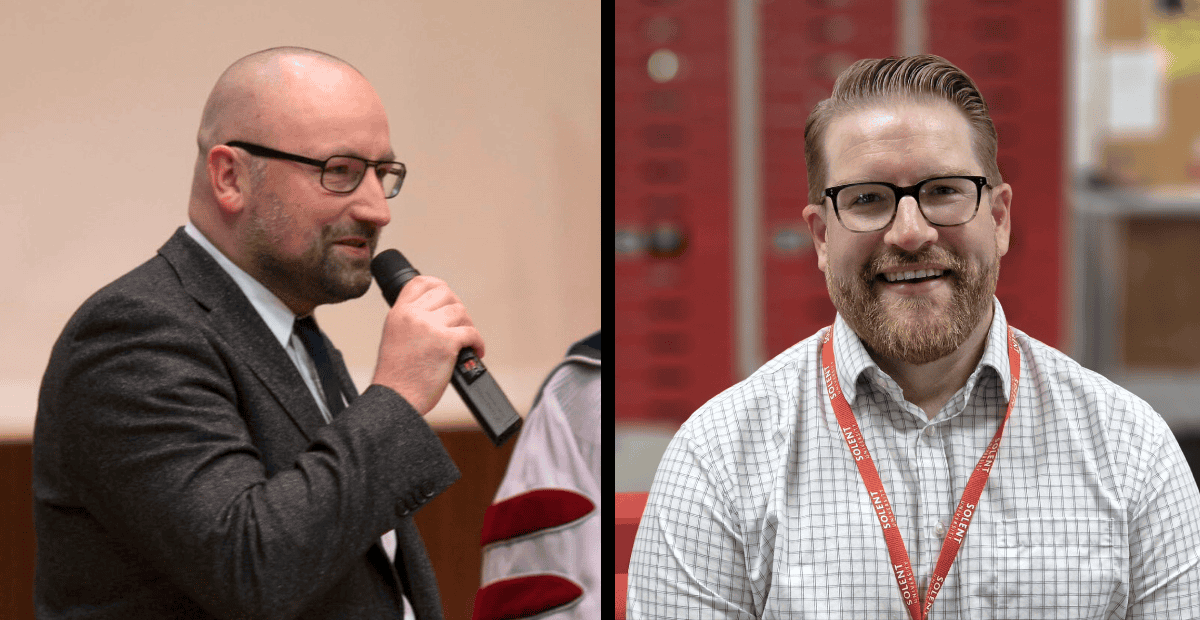Taking Libraries into the Future, Part 2: An Interview with Mike Jones and Tomasz Stompor
Social media in the academic library: a helpful asset or a time-waster of dubious ethical standards? This week's interview taps into the insights and best practices of two innovative professionals in the field.
Learn more about “Taking Libraries into the Future,” De Gruyter and Gold Leaf’s webinar series for librarians.
This is the first of three blog posts that describe how social media may be used by librarians to reach the communities that they serve. Gold Leaf’s Linda Bennett spoke to Mike Jones and Tomasz Stompor, who discuss the practical and ethical issues involved and offer advice on how to engage effectively with social media. They emphasize the need to manage expectations, pointing out that the social media platforms cannot offer a ‘silver bullet’ that fulfils all librarians’ communications needs; but they also affirm that, used judiciously as part of a wider strategy, it can make an important contribution to academia. As Mark Hughes prompted in the previous instalment of Taking Libraries into the Future, perhaps the key question is how we use this technology, and to what end?
Mike Jones is an Information Librarian at the Solent University in Southampton, UK. His role includes working with academics as a subject librarian and supporting both students and academics with resources and the know-how to use them. Tomasz Stompor is an academic librarian and independent researcher, currently based at the Cooperative Library Network of Berlin-Brandenburg (KOBV), Zuse-Institute Berlin. He is a project coordinator at DeepGreen, a data hub for open access articles. He uses social media to communicate current developments of the projects in which he is involved and to keep in touch with those interested in his work.

Linda Bennett: How did you first become interested in using social media as part of your job?
Mike Jones: I have long been interested in using social media as a tool to attract interest in a library’s services and collections. I began to develop it at least thirteen years ago, when I was working at a Sixth Form College. Later I studied for a master’s in library and information management and wrote my dissertation on how libraries could use social media as a marketing tool, particularly the small ones that have very few staff members. The widely held belief that students are all digital-savvy and have been proficient at using electronic and online resources since primary school is a myth. The pandemic showed that students relied on print; many did not know how to access and use e-books; however, almost all use social media.
Tomasz Stompor: I use social media as a tool to reach visibility and to communicate news about the progress of a project. An important key to remaining visible is to maintain a certain regularity of messages. The exact process depends on the outlet you are using.
LB: How effective is social media at raising awareness of the library?
“The more difficult challenge is to communicate library projects to the greater academic community, as it requires greater power of persuasion and an effort to spark attention in the first place.”
MJ: Some very interesting work has been done by public libraries, particularly in far-flung places like Orkney, Scotland, where librarians have developed ‘fun’ personas on Twitter/X. Academic librarians engage in a different way, because their relationship with their patrons is different. Effectively it is about targeting a relatively small population. We found that 16-to-18-year-olds were not very interested in engaging with librarians in this way; they prefer to use social media to keep in touch with their friends and don’t want college life invading their personal space. They told me that email was the best way of reaching them, but in practice it was more likely that they would read the social media posts. So it is all about finding a balance. To academic librarians, harnessing social media may seem quick and easy – after all, you’re going directly to where the audience is – but you must guard against getting sucked into spending too much time and effort on it.
TS: Let me try to approach this question from my German perspective. The world of academic libraries in Germany is made up of a variety of interest groups that are often organized in professional societies, regional networks, mailing lists, forums and regular thematic meet-ups. It is quite easy to advertise new projects, depending on the channels you choose. In my opinion, the key to reaching wide audiences is personal contact, as it lends your message credibility. Whenever I am confronted with the task of communicating something important, I always talk to colleagues to point me in the right direction. It’s very useful to share knowledge about your personal professional networks, in order to find out where to direct your communication. The more difficult challenge is to communicate library projects to the greater academic community (researchers, students, administration), as it requires greater power of persuasion and an effort to spark attention in the first place.
LB: Do you have any concerns about the ethical standards – or lack of them – for which some social media companies have recently been criticized?
MJ: I am very aware of this, and I think that students and academics are now much more attuned to the complications and issues involved. It’s not just about the politics or the toxic culture that can be too easily developed through social media; it’s also about how these companies collect and use personal data. You don’t have to be a conspiracy theorist to believe that social media influenced Brexit or the Trump 2016 election.
“To academic librarians, harnessing social media may seem quick and easy … but you have to guard against getting sucked in to spending too much time on it.”
People aged 18-25 were once the core social media users but they are now becoming much more skeptical about the overall objectives of these platforms and whether they want to support them. There has certainly been a drop-off in how Twitter/X and Facebook are used by that demographic. Instagram and TikTok are now better supported by that group – and both need more thought and technical expertise to be used effectively. For academic libraries, this means a greater investment in time and training: we have had to move from just putting stuff ‘out there’ to thinking about how to present the message. Content description and video clip creation is much more part of our role than it was. In some ways this is a good thing – we’ve had to master new skills and learn how to think creatively. Help is available without too much expense – Instagram and TikTok both have inbuilt tuition – and Canva is much easier to use than Photoshop. These aids make it all very doable, but librarians still find it difficult to build in the extra time.
TS: Social media provides a powerful marketing tool that, unfortunately, comes with many negative tradeoffs. Currently many librarians and institutions in Germany have left Twitter/X for other platforms like Mastodon, LinkedIn and Bluesky for political reasons (inhumane content, trolling, spam bots) and the erratic changes in the functionality of the platform. The downside to this development is that the information bubbles in social media tend to shrink even more when their landscape becomes increasingly fragmented.
LB: Is there a fundamental difference between how academics and students deploy social media and therefore how the library engages?
“[Social media] remains an important asset, but as an extension of real-world engagement with students and academics, not as a replacement for this.”
TS: In the context of libraries, especially academic libraries, my impression is that the social media sphere is very self-centered. The communication that happens is intradisciplinary, in that library professionals tend to communicate with peers and publishers rather than patrons and academics.
MJ: The most effective way of reaching students is and always has been through academics. We can reach the students if we can get the academics to take notice of our social media feeds and pass them on. Academics are the greatest influencers of undergraduates. Therefore, if the library feeds only reach one hundred academics, the effort put into creating them will still have been worthwhile. It means that we’re connecting with real-world colleagues and at Solent we do this very well. It’s part of a cohesive strategy and helps us to show what we do in the library through social media.
LB: So do you think that social media has been over-hyped? Is it really a useful tool for librarians?
TS: Many services provided by libraries remain hidden and are taken for granted by academics. Libraries are service providers, and it is good if these services run smoothly. Still, much more could be gained towards achieving open research and open publication practices from a closer collaboration between researchers and librarians, if the latter were perceived as allies and sources of expertise by the former. Social media can help, in certain contexts.
MJ: I think the value of social media can be over-emphasized. It seems easy to engage with, it’s stimulating, interesting and it can be made to work, but usually only as part of a wider strategy. The academic librarian community’s use of social media to connect colleagues with each other and to reach academics has been far more effective than using it to connect with students. The library has sporadic successes with students via outreach programs, but there is no coherent student community.
“…much more could be gained towards achieving open research and open publication practices from a closer collaboration between researchers and librarians … social media can help, in certain contexts.”
Academics are similar to librarians in that they have been very successful in creating their own online communities – sometimes with worldwide reach – based on their skills and research interests. Many have moved from Twitter/X to Bluesky. Getting peer support globally is so much more enriching than being marketed to. For me, the key thing to making social media work has always been about knowing the audience and what they will respond to. This is what I discovered when I researched for my MA a decade ago, and it still holds true.
So social media can be a great tool, but only when it’s used with a specific purpose in mind. It remains an important asset, but as an extension of real-world engagement with students and academics in the library and across the campus, not as a replacement for this.
Look out for our next post on social media, which will give examples from librarians around the world on ways in which they have successfully harnessed social media to help their patrons.
LB: Mike Jones and Tomasz Stompor, thank you both very much indeed.
Look out for our next post on social media, which will give examples from librarians around the world on ways in which they have successfully harnessed social media to help their patrons.
You might also be interested in this blog series
[Title Image by ajijchan/iStock/Getty Images]
